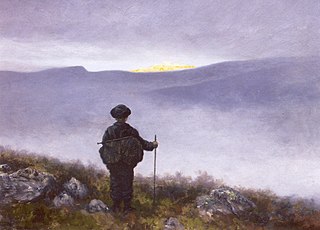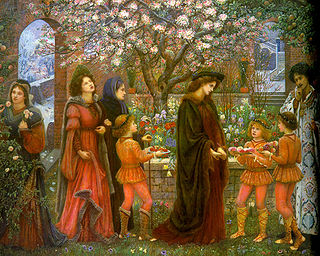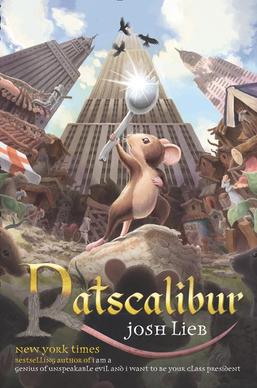
Merlin is a mythical figure prominently featured in the legend of King Arthur and best known as a magician, with several other main roles. The familiar depiction of Merlin, based on an amalgamation of historic and legendary figures, was introduced by the 12th-century British pseudo-historical author Geoffrey of Monmouth and then built on by the French poet Robert de Boron and their prose successors in the 13th century.

A quest is a journey toward a specific mission or a goal. It serves as a plot device in mythology and fiction: a difficult journey towards a goal, often symbolic or allegorical. Tales of quests figure prominently in the folklore of every nation and ethnic culture. In literature, the object of a quest requires great exertion on the part of the hero, who must overcome many obstacles, typically including much travel. The aspect of travel allows the storyteller to showcase exotic locations and cultures. The object of a quest may also have supernatural properties, often leading the protagonist into other worlds and dimensions. The moral of a quest tale often centers on the changed character of the hero.

The absent-minded professor is a stock character of popular fiction, usually portrayed as a talented academic whose academic brilliance is accompanied by below-par functioning in other areas, leading to forgetfulness and mistakes. One explanation of this is that highly talented individuals often have unevenly distributed capabilities, being brilliant in their field of choice but below average on other measures of ability. Alternatively, they are considered to be so engrossed in their field of study that they forget their surroundings. The phrase is also commonly used in English to describe people who are so engrossed in their own world that they fail to keep track of their surroundings. It is a common stereotype that professors get so obsessed with their research that they pay little attention to anything else.

Wisdom literature is a genre of literature common in the ancient Near East. It consists of statements by sages and the wise that offer teachings about divinity and virtue. Although this genre uses techniques of traditional oral storytelling, it was disseminated in written form.
Puer aeternus in mythology is a child-god who is eternally young. In the analytical psychology of Carl Jung, the term is used to describe an older person whose emotional life has remained at an adolescent level, which is also known as "Peter Pan syndrome", a more recent pop-psychology label. In Jung's conception, the puer typically leads a "provisional life" due to the fear of being caught in a situation from which it might not be possible to escape. The puer covets independence and freedom, opposes boundaries and limits and tends to find any restriction intolerable.

Alazṓn is one of three stock characters in comedy of the theatre of ancient Greece. He is the opponent of the eirôn. The alazṓn is an impostor that sees himself as greater than he actually is. The senex iratus and the miles gloriosus are two types of alazṓn.

Two Essays on Analytical Psychology is volume 7 of The Collected Works of C. G. Jung, presenting the core of Carl Jung's views about psychology. Known as one of the best introductions to Jung's work, the volumes includes the essays "The Relations between the Ego and the Unconscious" and "On the Psychology of the Unconscious" (1943).

A magician, also known as an archimage, mage, magus, magic-user, spellcaster, enchanter/enchantress, sorcerer/sorceress, warlock, witch, or wizard, is someone who uses or practices magic derived from supernatural, occult, or arcane sources. Magicians enjoy a rich history in mythology, legends, fiction, and folklore, and are common figures in works of fantasy, such as fantasy literature and role-playing games.
Jungian archetypes are a concept from psychology that refers to a universal, inherited idea, pattern of thought, or image that is present in the collective unconscious of all human beings. The psychic counterpart of instinct, archetypes are thought to be the basis of many of the common themes and symbols that appear in stories, myths, and dreams across different cultures and societies. Some examples of archetypes include those of the mother, the child, the trickster, and the flood, among others. The concept of the collective unconscious was first proposed by Carl Jung, a Swiss psychiatrist and psychoanalyst.
Merlin the Magician is a superhero in the publications of Quality Comics in the 1940s and, briefly in the 1990s, by DC Comics. Merlin first appeared in National Comics #1. The character is a direct descendant of the Arthurian wizard Merlin and spent most of his time fighting Nazis, using, as his title page frequently read, "occult powers to aid democracies in their fight against oppression".
Stories involving the mythical wizard Merlin have been popular since the Renaissance, especially with the renewed interest in the legend of King Arthur in modern times. As noted by Arthurian scholar Alan Lupack, "numerous novels, poems and plays center around Merlin. In American literature and popular culture, Merlin is perhaps the most frequently portrayed Arthurian character."
The Book of Sirach, also known as The Wisdom of Jesus the Son of Sirach or Ecclesiasticus is a Jewish work, originally written in Biblical Hebrew. The longest extant wisdom book from antiquity, it consists of ethical teachings, written approximately between 196 and 175 BCE by Yeshua ben Eleazar ben Sira, a Hellenistic Jewish scribe of the Second Temple period.
In Jungian psychology, the Wise Old Woman and the Wise Old Man are archetypes of the collective unconscious.
The personification of wisdom, typically as a righteous woman, is a motif found in religious and philosophical texts, most notably in the Book of Proverbs in the Hebrew Bible and other Jewish and Christian texts.
Senex is a Latin word literally meaning a man of old age.

The fool is a stock character in creative works and folklore. There are several distinct, although overlapping, categories of fool: simpleton fool, wise fool, and serendipitous fool.

Ratscalibur is a 2015 children's novel written by Josh Lieb and illustrated by Tom Lintern. It is a humorous fantasy set in New York City and loosely based on the Arthurian legends. It is the first book in the Chronicles of the Low Realm series.
Character pairing in The Lord of the Rings is a literary device used by J. R. R. Tolkien, a Roman Catholic, to express some of the moral complexity of his major characters in his heroic romance, The Lord of the Rings. Commentators have noted that the format of a fantasy does not lend itself to subtlety of characterisation, but that pairing allows inner tensions to be expressed as linked opposites, including, in a psychoanalytic interpretation, those of Jungian archetypes.
J. R. R. Tolkien's presentation of heroism in The Lord of the Rings is based on medieval tradition, but modifies it, as there is no single hero but a combination of heroes with contrasting attributes. Aragorn is the man born to be a hero, of a line of kings; he emerges from the wilds and is uniformly bold and restrained. Frodo is an unheroic, home-loving Hobbit who has heroism thrust upon him when he learns that the ring he has inherited from his cousin Bilbo is the One Ring that would enable the Dark Lord Sauron to dominate the whole of Middle-earth. His servant Sam sets out to take care of his beloved master, and rises through the privations of the quest to destroy the Ring to become heroic.

Scholars, including psychoanalysts, have commented that J. R. R. Tolkien's Middle-earth stories about both Bilbo Baggins, protagonist of The Hobbit, and Frodo Baggins, protagonist of The Lord of the Rings, constitute psychological journeys. Bilbo returns from his journey to help recover the Dwarves' treasure from Smaug the dragon's lair in the Lonely Mountain changed, but wiser and more experienced. Frodo returns from his journey to destroy the One Ring in the fires of Mount Doom scarred by multiple weapons, and is unable to settle back into the normal life of his home, the Shire.










